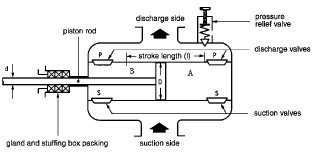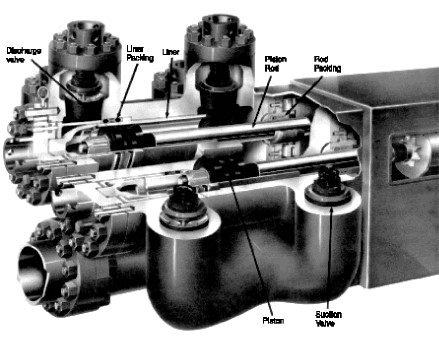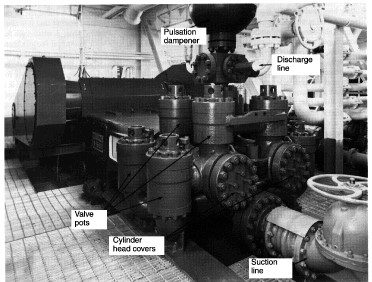High-pressure mud pumps are positive displacement pumps. Simply, they convert mechanical power into hydraulic power. Their mechanical components (power ends) are usually maintained by mechanics. However, the drilling crew maintains the pump’s hydraulic part (fluid end). As they are a critical part of the drilling rig equipment, it is mandatory that the drilling engineer should have a thorough knowledge of their mechanical and hydraulic components.
The mud pump nomenclature, as given in Figure 1, showing a cross-section of a duplex pump, should be studied carefully to obtain knowledge of the basic terminology.

In this article, we will deal with:
Working principles
General construction
Pulsation dampeners
Relief valves
Capacity, efficiency, and required power

The pump’s power end converts the prime mover’s rotary motion into a reciprocating motion. This reciprocating motion is, in turn, converted to fluid flow by a piston or plunger-type fluid end.
Crosshead: The mud pump part where rotary motion changes into reciprocating motion
The Connecting rod: It provides the linkage between the crank and crosshead.
The piston or plunger: This is connected to the crosshead by the extension rod and the piston rod.
The main parts of the pump’s fluid end are the housing itself, the liners with packing rings, covers plus packing, piston(s) with piston rods, and the suction and discharge valves with seats. (The discharge is normally supported with a pressure relief valve).
The plunger delivers during half the crank cycle only. For this reason, it is called a single-acting pump. We can calculate the delivery of a single piston during one cycle of such a pump as follows ( ignoring losses):

The double-acting piston mud pump is shown in Figure 2. This pump has only two pistons. The suction stroke on one side occurs simultaneously with the discharge stroke on the other. A double-acting pump delivers liquid both during the inward & outward piston strokes. So, comparing it with a single-acting pump having the same piston diameter and stroke, it is clear that the double-acting pump will pump almost twice as much liquid. The output is somewhat less due to the piston rod.

The main parts of the duplex mud pump fluid end are the same as those for the single-acting pump, except for the gland and stuffing box packing on the piston rod side and the additional set of valves per piston.


Figure 4 shows the fluid end of a double-acting duplex pump, showing major components.

Contact:Mr Liu
Mobile:15869109368
Tel:86-571-89967020
E-mail:info@dawopu.com
Address:No151 ,ZiDingXiang Rd, Hangzhou. Zhejiang Province, China